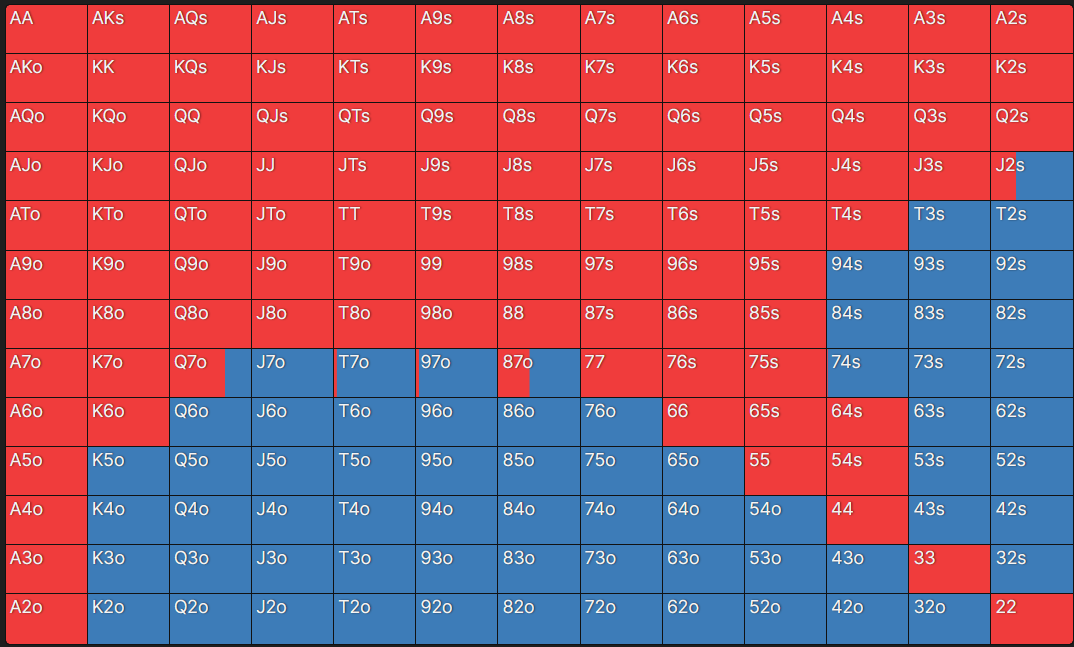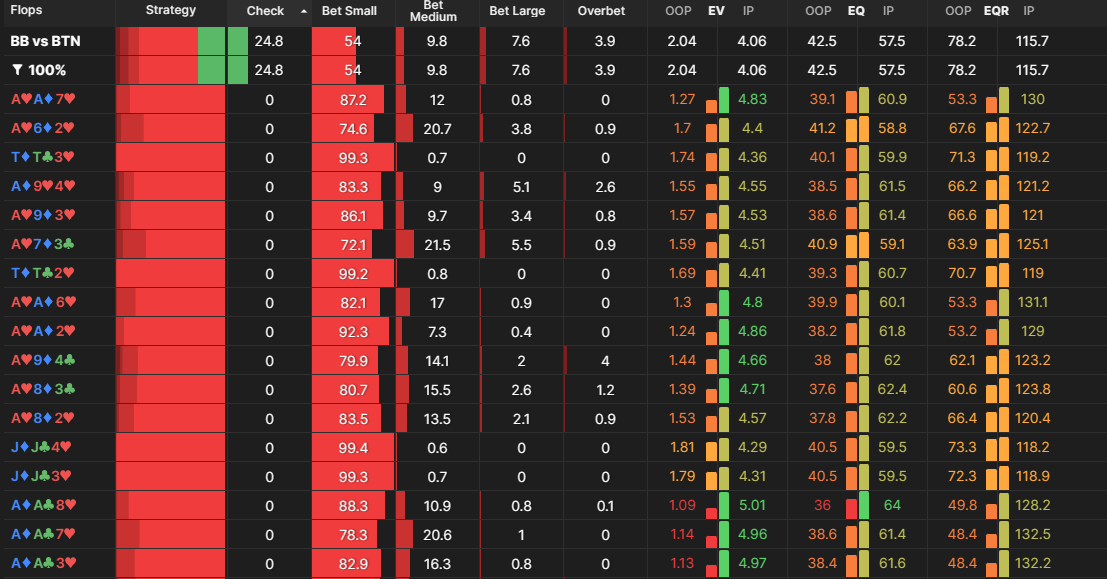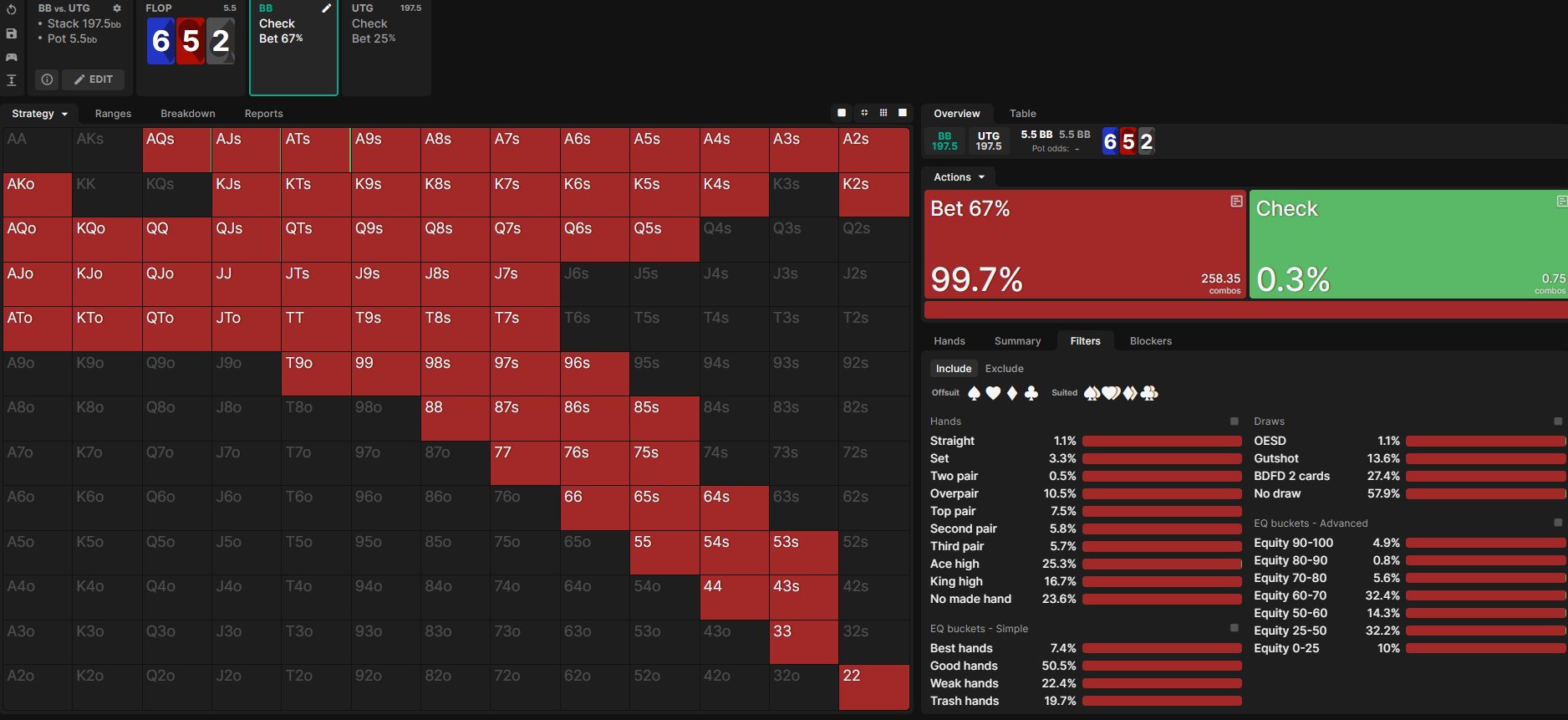Last week we shared a fantastic GTO Wizard video, that included a method for prioritising study. Tombos21 created a spreadsheet (which you can copy here) which showed the most common spots in poker, and ranked them in terms of their importance to your EV.
The top 10 (for 100BB cash games) is below. I suspect the ranking for MTTs will be very similar:

As you can see, the spots are judged by their frequency, average pot size and generally their expected value. It is no surprise to me that SB vs BB and BTN vs BB are the two priority spots because they come up the most often for sure. These are for single-raised pots, and I suspect some people might be surprised BTN vs SB 3-bet pot wasn’t higher (I thought it would be, too), but for sheer frequency, this makes sense to me. It’s a much better use of your time to master the recurring spots than huge outlier pots you remember because of a cooler.
Tombos21 recommended drilling these spots in GTOWizard, then once you achieve a certain score, moving on to the next one. I have decided to do the same thing, while also studying the spots here so you can study along with me.
I am going to pick BTN vs BB first, rather than SB vs BB. SB vs BB has such wide ranges I wanted to go easy on myself with the 2nd most common spot first. My stack depth to study is 40BBs, ChipEV, in tournaments.
First things first, let’s compare the preflop ranges:
 |
 |
The BTN opening range is wide and linear; they open 51% of hands. The BB defending range is also very wide, 59.2% of hands. It is, however, capped. It doesn’t contain any of the strong Ax hands or any pocket pairs, because all of those would have 3-bet preflop.
Therefore, I would expect the BTN to have range advantage on most flops, because they will always potentially have overpairs, the best top pairs, and the sets. If anything, the BB would have a slight range advantage on low boards because they have more hands like 43s and 62s. The BB has all the suited hands, so there may be a slight advantage on flush draw flops too.
However, as both ranges are very wide, most of the time, each player would miss the flop. Therefore, I can’t see a great deal of range betting or overbetting on any flop, because both player has so many misses.
Using the GTO Wizard flop reports, we can see that the BB checks 100% of the time, most of the time, on the flop. They check 98% of the time across all runouts, and the only boards where we see some leading are middle-connected flops like 654. We have already looked at this when we wrote about donk leads. The BB makes a straight, two pair, or a combo draw much more often on these flops.

You can also see from these reports that the BTN has a significant overall equity advantage of 57.4% compared to 42.6%. They win 4.04BBs on average compared to 2.06BBs of the BB, which is both down to their range advantage and position.
We can also use the GTO WIzard reports to test my hypothesis that we won’t see much range betting or overbetting from the BTN because while they have an advantage, they still have a wide range:
Below are the most favoured boards to bet for the BTN, when checked to:

The most favoured boards are Ace high boards, which makes sense because BTN has all the best Ax hands, and high paired boards. Both players can connect with these flops, but when the BTN does, they often have a kicker advantage, too.
You can see that overall the BTN bets around 75% of the time, 54% of the time using a small bet sizing and just a little over 10% of the time using a large or overbet size. On the Ace high and paired boards the preferred bet size is small.
These are the boards where the BTN makes a large bet with some frequency:

What sticks out about these boards is that they are all dynamic, ie. there are a lot of turn cards that could change who has range advantage. A board like A8Q or 974 are the sort of board where a lot of cards could complete a flush or straight and slow down the action. Therefore, the player with range advantage wants to bet larger with hands like top pair now while they are definitely ahead.
The boards where there is some overbetting for the BTN include:

These are what I would call polarised flops for the BTN. The BTN either has a very strong hand on a 852 flop (mostly sets or overpairs) or misses with hands like AK. The BTN is unlikely to have hit two pair or a draw on this board. Therefore, the betting strategy includes having an overbet range of strong hands and bluffs to get the most value from those hands, because they don’t connect with this board often enough to bet their entire range.
Let’s look at one more thing before we call it a day: the check/raising from the BB. These are the boards where the BB check/raises a small bet the most often:

The BB check/raises 17.5% of the time on average across all flops when facing a small bet. The favoured board to check/raise appears to be medium-paired boards with a flush draw on them. This makes sense if you scroll back up to the preflop range as the BB has all the medium cards and all the flush draws, the BTN does not. The value bets here will be mostly trips, and the bluffs will be mostly flush draws.
This is just the tip of the iceberg about what we can learn from GTO Wizard about common spots like BTN vs BB, single-raised pots, but we already have much to go on. The BTN has a significant range advantage and favours betting small on Ace high flops, bets larger on more dynamic boards, and overbets flops that are hard to hit. The BB checks most of the time because they are at a range and positional advantage; when they lead, it is middle connected boards, when they check/raise it is usually on medium paired boards with a flush draw.
Let me know what you think of this analysis; I’ll be exploring these common spots in more depth as the weeks go on.
What is GTOWizard?

GTO Wizard is an advanced GTO trainer that shows you how to play against a perfect opponent.
You can play full hands from preflop to river to learn anything and everything you need to know to make your game harder to exploit.
The interface is designed with learning in mind, with custom filters to drill down on important information, dynamic training modes to fine-tune spots, and advanced AI to do your own solves.
You can also upload your hand histories to get your own GTO score and discover where you need to improve. GTO Wizard also has some of the best free strategy content available anywhere in poker.
10% discount on GTOWizard
Using the bonus code PokerStrategy you can get a 10% discount on your first subscription.
There are custom plans for Cash Games, Cash Games with Straddles/Antes, MTTs, Spin & Go and HUSNGs. Each plan has unique features for the game type (for example ICM and PKO solutions for MTTs) but all of them have the following features:
| Starter (from $39/month) | Premium (from $69/month) | Elite (from $109/month) |
|---|---|---|
| Postflop solutions (Most stack depths) | Everything from Starter | Everything in Premium |
| Unlimited practice spots | Postflop solutions (All stack depths) | AI custom solving |
| 50 spots a month to analyse | Blockers score | Dynamic bet sizing |
| Basic aggregated reports | 100,000 spots a month to analyse | 150,000 spots a month to analyse |
| Turn aggregated reports | New features coming soon | |
| Weekly coachings |
Get 10% off GTO Wizard
How do you rate your BTN vs BB game? Let us know in the comments:
